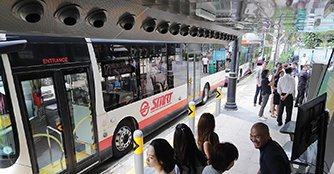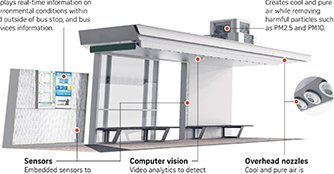An oasis of cool, clean air for bus commuters
13 Mar 2018|1,484 views
Waiting for a bus near Plaza Singapura? No sweat. A trial bus stop, built by ST Engineering, comes with overhead nozzles that deliver air-con-cool air that the company says is also more than 90% cleaner, with harmful PM2.5 particles filtered out. The smart bus stop has a high-tech camera system, which tracks commuter flow and average waiting times.
It also has algorithms that can spot unattended baggage or suspicious individuals loitering around.
Launched yesterday, the bus stop, erected alongside an existing one outside Plaza Singapura, is on trial for a year.
The project is funded by ST Engineering, which also wants to explore how its air-cooling systems - currently used in places such as the Singapore Zoo - can be applied to other settings.
Compared with conventional air-conditioners, which employ refrigerants and generate heat, the company's Airbitat Oasis system creates a reservoir of cold water through evaporative cooling, which is, in turn, used to cool the air it blows out.
Sensors embedded in the bus-stop infrastructure monitor air temperature and purity, levels of which are displayed on a touchscreen board. The bus stop was developed over 18 months by ST Engineering subsidiary Innosparks, a research and development outfit and start-up incubator.
Innosparks head Gareth Tang said the air-cooling system and sensors can easily be retrofitted to existing bus stops. He declined to reveal how much the bus stop costs.
But he said the Airbitat Oasis unit costs around 60 cents an hour to run, while it is more than $2 for an air-conditioning system.
Mr. Tang said that Innosparks will conduct commuter surveys and share the data collected at the bus stop with the Land Transport Authority.
Commuters in general welcomed the cool wait. Retiree Michael Lim, 70, said he appreciated the feature but did not think it was necessary to cool every bus stop as most Singaporeans are used to the warm weather.
Mr. Tang explained that while the air coming out of the blowers can be as cool as 24 degrees Celsius, its temperature rises a few degrees as it enters the warmer ambient outdoor environment.
Similarly, the air from the blowers is more than 90% cleaner, but the level can drop to about 50% as it gets mixed with the ambient air. Mr. Tang said, "It is still a lot better than the outdoor conditions. You can actually smell the clean air and not smell the bus exhaust."
Waiting for a bus near Plaza Singapura? No sweat. A trial bus stop, built by ST Engineering, comes with overhead nozzles that deliver air-con-cool air that the company says is also more than 90% cleaner, with harmful PM2.5 particles filtered out. The smart bus stop has a high-tech camera system, which tracks commuter flow and average waiting times.
It also has algorithms that can spot unattended baggage or suspicious individuals loitering around.
Launched yesterday, the bus stop, erected alongside an existing one outside Plaza Singapura, is on trial for a year.
The project is funded by ST Engineering, which also wants to explore how its air-cooling systems - currently used in places such as the Singapore Zoo - can be applied to other settings.
Compared with conventional air-conditioners, which employ refrigerants and generate heat, the company's Airbitat Oasis system creates a reservoir of cold water through evaporative cooling, which is, in turn, used to cool the air it blows out.
Sensors embedded in the bus-stop infrastructure monitor air temperature and purity, levels of which are displayed on a touchscreen board. The bus stop was developed over 18 months by ST Engineering subsidiary Innosparks, a research and development outfit and start-up incubator.
Innosparks head Gareth Tang said the air-cooling system and sensors can easily be retrofitted to existing bus stops. He declined to reveal how much the bus stop costs.
But he said the Airbitat Oasis unit costs around 60 cents an hour to run, while it is more than $2 for an air-conditioning system.
Mr. Tang said that Innosparks will conduct commuter surveys and share the data collected at the bus stop with the Land Transport Authority.
Commuters in general welcomed the cool wait. Retiree Michael Lim, 70, said he appreciated the feature but did not think it was necessary to cool every bus stop as most Singaporeans are used to the warm weather.
Mr. Tang explained that while the air coming out of the blowers can be as cool as 24 degrees Celsius, its temperature rises a few degrees as it enters the warmer ambient outdoor environment.
Similarly, the air from the blowers is more than 90% cleaner, but the level can drop to about 50% as it gets mixed with the ambient air. Mr. Tang said, "It is still a lot better than the outdoor conditions. You can actually smell the clean air and not smell the bus exhaust."
Latest COE Prices
August 2025 | 1st BIDDING
NEXT TENDER: 20 Aug 2025
CAT A$102,009
CAT B$123,498
CAT C$70,001
CAT E$122,334
View Full Results Thank You For Your Subscription.





















